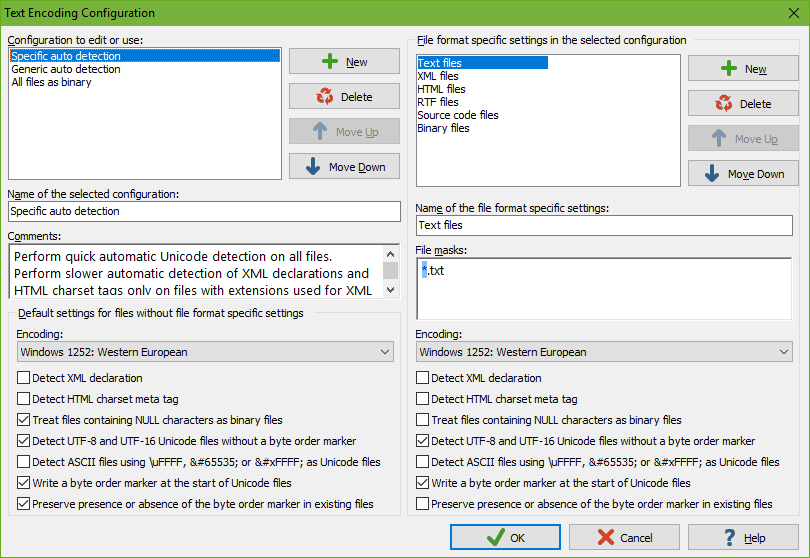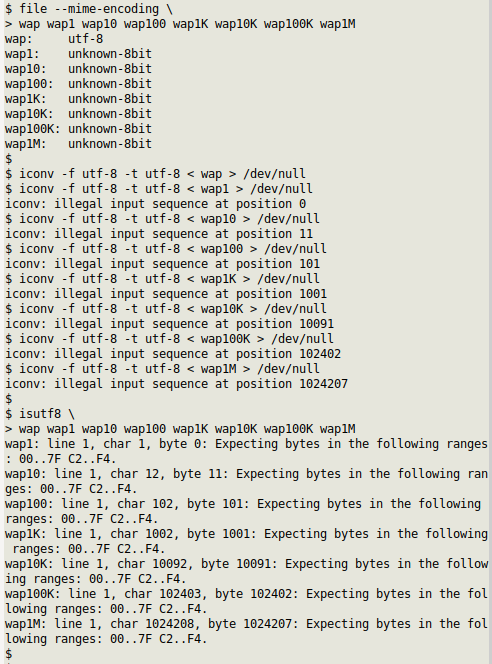
First, Plywood decides whether it’s better to interpret the file as UTF-8 or as plain bytes. It’s only when we enter the bottom half of the flowchart that some guesswork begins to happen.
#TEXT ENCODING DETECTOR CODE#
(A control code is considered to be any code point less than 32 except for tab, linefeed and carriage return.) There are lots of invalid byte sequences in UTF-8, so if a text file can be decoded as UTF-8 and doesn’t contain any control codes, then it’s almost certainly a UTF-8 file. The first two checks handle the vast majority of text files I’ve encountered. Plywood analyzes up to the first 4KB of the input file in order to guess its format. Here’s how Plywood’s automatic text format detection currently works: Does the file start with a BOM? Use BOM encoding Can the file be decoded as UTF-8 without any errors or control codes? Use UTF-8 When decoding as UTF-8, are there decoding errors in more than 25% of non-ASCII code points? The 8-bit format is UTF-8 The 8-bit format is plain bytes Try decoding as little and big-endian UTF-16, then take the best score between those and the 8-bit format Detect line ending type (LF or CRLF) Done yes yes yes no no no This allows Plywood applications to work with a single encoding internally. Conversion is performed on the fly if needed. The input stream returned from these functions never starts with a BOM, is always encoded in UTF-8, and always terminates each line of input with a single carriage return \n, regardless of the input file’s original format. If you don’t know the exact format, you can call FileSystem::openTextForReadAutodetect(), which will attempt to detect the format automatically and return it to you.If you know the exact format of the text file ahead of time, you can call FileSystem::openTextForRead(), passing the expected format in a TextFormat structure.

When opening a text file using Plywood, you have a couple of options: Plywood is a cross-platform open-source C++ framework I released two months ago. And even if a text file is encoded in UTF-8, there are still variations in format, since the file may or may not start with a BOM and could use either UNIX-style or Windows-style line endings. In other words, the ambiguity problem still exists today.
#TEXT ENCODING DETECTOR WINDOWS#
When writing a text file from Python, the default encoding is platform-dependent on my Windows PC, it’s Windows-1252. The Windows Registry editor, for example, still saves text files as UTF-16. UTF-8 hasn’t taken over the world just yet, though. It’s impressive how quickly that number has changed it was less than 10% as recently as 2006. More than 95% of the Internet is now delivered using UTF-8. Fortunately, the text file landscape has gotten simpler over time, with UTF-8 winning out over other character encodings.

It’s a problem that has been around for a while.

#TEXT ENCODING DETECTOR SOFTWARE#
This poses a challenge to software that loads text. That’s obviously an artificial example, but the point is that text files are inherently ambiguous.

Lines of text could be terminated with a linefeed character \n (typical on UNIX), a CRLF sequence \r\n (typical on Windows) or, if the file was created on an older system, some other character sequence. The file may or may not begin with a byte order mark (BOM). The text could be encoded as ASCII, UTF-8, UTF-16 (little or big-endian), Windows-1252, Shift JIS, or any of dozens of other encodings. This text file can take on a surprising number of different formats.


 0 kommentar(er)
0 kommentar(er)
